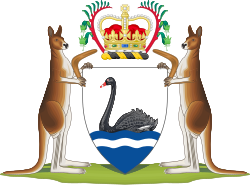| State Government | |
  The corporate logo (top) and state coat of arms (bottom) | |
| Formation |
|
|---|---|
| Founding document | Constitution of Western Australia |
| State | |
| Country | |
| Website | wa |
| Crown | |
| Head of state | Charles III |
| Vice-regal representative | Governor Chris Dawson |
| Seat | Government House |
| Legislative branch | |
| Legislature | Parliament of Western Australia, comprising: |
| Meeting place | Parliament House |
| Executive branch | |
| Head of government | Premier Roger Cook |
| Main body | Western Australian Ministry |
| Appointed by | Governor on behalf of the King |
| Headquarters | Dumas House |
| Main organ | Executive Council |
| Departments | Approximately 130 agencies and authorities |
| Judicial branch | |
| Court | Supreme Court |
| Seat | David Malcolm Justice Centre [1] |
The Government of Western Australia, also known as the WA Government, is the executive branch of government for the Australian state of Western Australia. It comprises the State Cabinet, Executive Council and the public sector. The WA Government includes approximately 130 agencies and authorities delivering frontline and support services, employs approximately 240,000 people and had an expected operating expenditure of A$43.59 billion in the 2024–25 financial year. [2] [3] [4]
Contents
- History
- Executive and judicial powers
- Ministries
- Current composition
- See also
- References
- External links
The state's founding constitution was enacted in 1890, with the state being a democratic constitutional monarchy. Since federation in 1901, Western Australia has been a constituent state of the Commonwealth of Australia, and the Commonwealth Constitution regulates its relationship with the Australian Government. The legislative branch takes the form of the bicameral Parliament of Western Australia, comprising the Legislative Assembly (lower house), Legislative Council (upper house), and the monarch of Australia represented through the Governor. The judicial branch comprises the Supreme Court of Western Australia and the lower courts.









